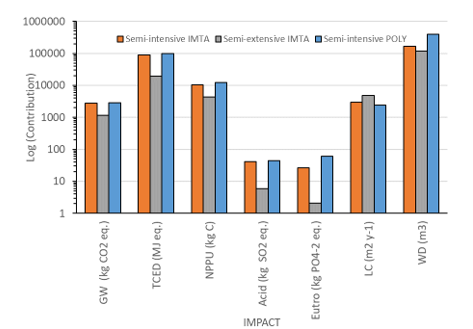COMPARATIVE LIFE CYCLE ASSESSMENT OF SEMI-INTENSIVE AND EXTENSIVE POND IMTA AND SEMI-INTENSIVE CONVENTIONAL FISHPOND PRODUCTION
Introduction
In southwest Iberia extensive and semi-intensive fish culture in earthen ponds are traditional activities in saltmarsh. The most used commercial fish species are gilthead seabream ( Sparus aurata) and sea bass (Dicentrarchus labrax ). Since most of this activity takes place in protected areas, intensifying the production is out of the question, however increasing product diversification with IMTA, may provide an answer by creating a balanced system for environmental sustainability of earthen ponds while increasing their profitability and social acceptability. L ife cycle assessment (LCA) was used t o evaluate the environmental footprint of semi-intensive and semi-extensive pond IMTA in comparison to semi-intensive conventional fishpond production (POLY).
Methods
The studied systems:
Scenario data for the systems considered in the study:
The impact categories:
Global Warming (GW) in kg CO2-equivalents, Net Primary Production Use (NPPU) in kg C, Total Cumulative Energy Demand (TCED) in MJ-equivalents, Acidification (Acid) in kg SO2-equivalnets, Eutrophication (Eutro) in kg PO4- equivalents, Land Competition (LC) in m2, and Water Dependence (WD) in m3.
Results
Comparative contributions of different impact categories of each rearing system calculated for 1 tonne of aquatic products as functional unit (Fig. bellow) show that eutrophication (Eutro ), a cidification p otential (Acid) and t otal c umulative e nergy d emand (TCED) showed the largest difference between the semi-intensive and semi-extensive production systems. Except for l and c ompetition (LC), IMTA systems had lower contribution to the impacts when compared to the polyculture system. This was most noticeable for the semi-extensive IMTA system that had the lowest impacts. The impact of the semi-intensive IMTA system on global warming was only slighter lower than that of the polyculture semi-intensive system. However, e utrophication and w ater dependence were also much lower.
Conclusions
Conclusions from the environmental impact study of pond integrated multi-trophic aquaculture (IMTA) in semi-extensive and semi-intensive systems in comparison to semi-intensive fishpond polyculture show that:
- With exception of land competition, semi-extensive IMTA has an overall lower environmental impact compared to semi-intensive IMTA and semi-intensive fish polyculture,
- To produce the same amount of fish biomass the semi-intensive IMTA is much less eutrophic and water dependent than semi-intensive fish polyculture,
- The semi-intensive IMTA used less feed than the semi-intensive fishpond polyculture to produce the same amount of seafood biomass.
Acknowledgements
The authors want to acknowledge INTERREG V A Espanha Portugal (POCTEP) program, project 0750_AQUA_AMBI_2_5_P – Apoio à gestão das zonas húmidas do litoral do Sudoeste Ibérico: interação entre a Aquacultura e o meio Ambiente na região transfronteiriça Alentejo-Algarve-Andaluzia – FASE 2

